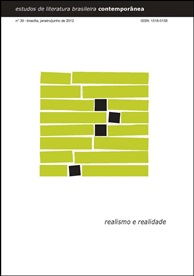Refiguração do tempo histórico pela ficção
DOI:
https://doi.org/10.1590/S2316-40182012000100005Abstract
M. Bakhtin afirma que a representação de acontecimentos, relações e processos no romance deve abranger a totalidade de uma época - nela deve haver uma peculiar concatenação, literariamente expressa, espácio-temporal. Essa formulação contém elementos basilares para o entendimento e análise do romance, objeto deste estudo, Leite derramado de 2009 de Chico Buarque. A narrativa figura, pelo menos, duas grandes épocas históricas do Brasil: uma que vai do início do século XIX até 1930 e outra que vai desse momento ao início do XXI. É a representação da saga histórica da decadência de uma categoria social (fração da classe dominante), personificada na família Assumpção, com seus valores éticos e culturais, suas concepções de mundo e seu comportamento, estilizando sua dissolução social e moral. Ao fazer isso o romance coloca inúmeros problemas - desde humano-existenciais até histórico-políticos - para a reflexão do leitor.
Downloads
References
BAKHTIN, Mikhail (2003). Estética da criação verbal. 4. ed. Trad. Paulo Bezerra. São Paulo: Martins Fontes.
BUARQUE, Chico (2009). Leite derramado. São Paulo: Cia das Letras.
CANDIDO, Antonio (1979). “Prefácio”. In: MICELI, Sergio. Intelectuais e classe dirigente no Brasil (1920-1945). São Paulo: Difel. p. ix”“xiii.
FREYRE, Gilberto (1952). Casa-grande & senzala. 7. ed. Rio de Janeiro: José Olympio.
GENETTE, Gérard (1972). “Espaço e linguagem”. In: _____. Figuras. Trad. Ivonne F. Mantoanelli. São Paulo: Perspectiva. p. 99-106.
HEGEL, Georg Wilhelm Friedrich (1992). Fenomenologia do espírito. Trad. Paulo Menezes. Petrópolis: Vozes. parte 1.
KINZO, Maria D’Alva Gil (1980). Representação política e sistema eleitoral no Brasil. São Paulo: Símbolo.
LA BOÉTIE, Étienne de (1982). Discurso da servidão voluntária. Trad. Laymert Garcia dos Santos. São Paulo: Brasiliense.
LUKÁCS, Georg (2009). Arte e sociedade: escritos estéticos (1932-1967). Trad. Carlos Nelson Coutinho e José Paulo Netto. Rio de Janeiro: UFRJ.
______ (1965). Ensaios sobre literatura. Trad. Leandro Konder. Rio de Janeiro: Civilização Brasileira.
______ (1968). Marxismo e teoria da literatura. Trad. Carlos Nelson Coutinho. Rio de Janeiro: Civilização Brasileira.
MENDILOW, Adam Abraham (1972). O tempo e o romance. Trad. Flávio Wolf. Porto Alegre: Globo.
QUEIROZ JÚNIOR, Teófilo de (1975). Preconceito de cor e a mulata na literatura brasileira. São Paulo: Ática.
REIS, Carlos; LOPES, Ana Cristina M. (1987). Dicionário de narratologia. Coimbra: Almedina.
RICOUER, Paul (1995). Tempo e narrativa. Trad. Marina Appenzeller. Campinas: Papirus. v. 2.
SCHWARZ, Roberto (2009). “Brincalhão, mas não ingênuo”. São Paulo: Folha de S. Paulo. Ilustrada. 28 mar., p. E 6”“7.
TOLEDO, Dionísio de Oliveira (1972). “Prefácio”. In: MENDILOW, Adam Abraham. O tempo e o romance. Trad. Flávio Wolf. Porto Alegre: Globo. p. ix”“xv.
Downloads
Published
How to Cite
Issue
Section
License
Authors who publish in this journal agree to the following terms:
a) The authors maintain the copyright and grant the journal the right of first publication, the work being simultaneously licensed under the Creative Commons Attribution License-Non Commercial 4.0 which allows the sharing of the work with acknowledgment of the authorship of the work and publication this journal.
b) Authors are authorized to enter into additional contracts separately, for non-exclusive distribution of the version of the work published in this journal (eg publish in institutional repository or as a book chapter), with authorship recognition and publication in this journal.
c) Authors are allowed and encouraged to publish and distribute their work online (eg in institutional repositories or on their personal page) after the editorial process, as this can generate productive changes, as well as increase the impact and citation of published work (See The Effect of Free Access).
d) The authors of the approved works authorize the magazine to, after publication, transfer its content for reproduction in content crawlers, virtual libraries and the like.
e) The authors assume that the texts submitted to the publication are of their original creation, being fully responsible for their content in the event of possible opposition by third parties.


